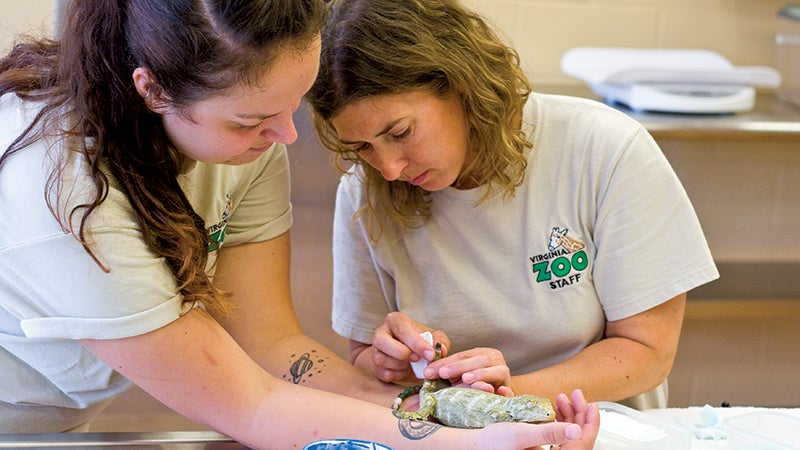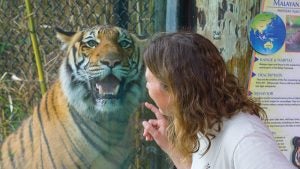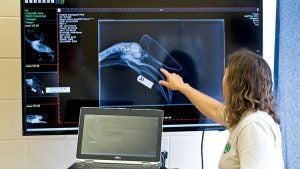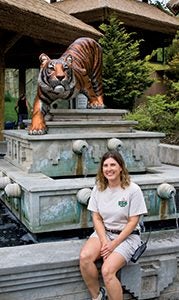Vet tech under the microscope
Published 2:00 pm Wednesday, May 24, 2017

- Suffolk resident Leah Rooker, right, a Virginia Zoo veterinary technician, and intern Marley Ueland do a treatment on a female New Caledonian Giant Gecko named Callie.
Suffolk resident Leah Rooker helps take care of hundreds of animals at the Virginia Zoo in Norfolk, ranging in size from a dart frog she can fit in her hand to a giraffe that won’t fit through the surgical room doors at the Animal Wellness Campus where she works.
But she has one thing in common with all of the animals in her care — she carries out a majority of her life in the public eye.
For the last couple of years, Rooker and her colleagues have worked in the new Animal Wellness Campus at the zoo. It’s a significant upgrade from the amount of space they had before, but it also has an educational component. Through large picture windows accompanied by signs explaining the work that goes on there, zoo visitors can watch Rooker and other animal care experts go about their daily duties, from doing routine exams on animals to taking X-rays and carrying out minor surgical procedures.
“I just love my job,” Rooker said. “It’s different every day.”

Leah Rooker greets one of two tiger cubs she helped hand-rear after they were born at the Virginia Zoo in January 2016. The naming rights to the cubs were auctioned at a zoo fundraiser, and both have Suffolk connections.
Rooker always knew she wanted to work with animals.
“I love animals and always wanted to do something with them,” she said.
Rooker, who grew up with a military parent but finished high school in Alexandria, went to Harcum College in Pennsylvania. She then moved on to Virginia Tech, where she earned her degree and worked in the large animal program for about 11 years, taking care of beasts such as horses, cows and sheep.
That wouldn’t seem to be very good preparation for caring for prairie dogs and white rhinos, but Rooker said it’s all about networking and on-the-job learning.
“You’re constantly learning,” she said. “If we don’t know something we’ve got a network of people we can contact.”
Rooker, together with the veterinarian at the zoo, does routine exams on all of the animals at the zoo. There are also special exams and treatment needed when something seems wrong. The Animal Wellness Campus has a variety of facilities in which to place animals in isolation or intensive care when needed.
Sometimes, the care gets very intensive, like when tiger cuts Stubbley and Osceola needed to be hand-reared after their mother was unable to care for them.
The cubs were born in January 2016, and Rooker was on the team that fed them by hand around the clock.
“It was really a cool experience to be able to hand-rear them,” Rooker said.
As it turns out, both tigers have a connection to Suffolk. Naming rights for the cubs were auctioned at a zoo fundraiser in August 2016. Chuck Stencel and his wife, of Chicago, Ill., named Osceola after their grandson, who was born in July 2016 in Suffolk.
Emery Wyatt and his wife, Suffolk residents and zoo members and volunteers, chose Stubbley’s name as a tribute to the first dog they owned together.
Even though Rooker isn’t supposed to have favorites, it’s clear the tiger cubs have a special place in her heart. Framed photos of her with the tigers stand on her desk, near ostrich eggs on a pedestal and photos of her with her own horse. She also has a cat and a dachshund at home.
Rooker can tell the cubs apart by the thickness of stripes on their tails and the direction their eyebrows turn. But she maintains a wariness that is a smart idea for wild animals.
“Even though we hand-reared the tigers, they’re not pets,” she said. “All these animals are still wild. I have a healthy respect for them, but I’m not scared of them.”
Though she might be near constantly in a fishbowl, so to speak, Rooker said she loves her job.
“It’s kind of a dream to be doing something I’m passionate about,” she said.








